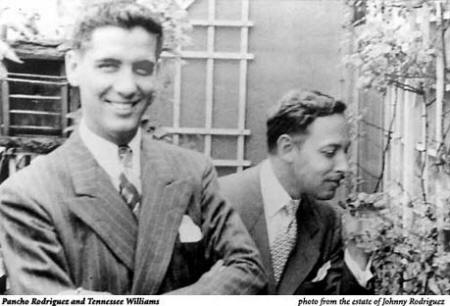

Partner Tennessee Williams
Queer Places:
632 St Peter St, New Orleans, LA 70130
Rancho Pancho, 773 Commercial St, Provincetown, MA 02657
 Amado
"Pancho" Rodríguez y González (December 1, 1920 – August
4, 1993) was born in Eagle Pass, Texas, and lived with Tennessee Williams at
632 Rue St. Peter in the French Quarter in the 1940s.
Amado
"Pancho" Rodríguez y González (December 1, 1920 – August
4, 1993) was born in Eagle Pass, Texas, and lived with Tennessee Williams at
632 Rue St. Peter in the French Quarter in the 1940s.
After the success of The Glass Menagerie, Tennessee Williams spent time in Mexico in late 1945. “I feel I was born in Mexico in another life,” he wrote in a letter from Mexico City. But luck was with Williams as he crossed la frontera at Piedras Negras/Eagle Pass: He met Pancho Rodriguez, a young Mexican American. The tale of that meeting would later be embellished—with Williams’ car breaking down and a border guard’s son helping to rescue a manuscript that border guards had confiscated.
The rising 34-year-old playwright was immediately smitten with the 24-year-old Pancho—the border guard’s son—and invited him to New Orleans as his live-in muse. The rest, as they say, is history. But the chronicle of their relationship was forgotten and, to a large extent, whitewashed from Williams’ life story.
In 1945, Tennessee Williams started living with Pancho Rodriguez, until he fell in love with Frank Merlo one and a half year later.
Elia Kazan, who directed both the stage and film versions of A Streetcar Named Desire, writes in his autobiography, My Life, about his difficulty understanding the love-hate relationship between Stanley and Blanche in a play now considered among the best of the 20th century. But it all became clear when he witnessed an altercation between Williams and Rodriguez: “If Tennessee was Blanche, Pancho was Stanley.” Their relationship ended when Streetcar opened on Broadway. By then Williams had a new muse, Frank Merlo. Despite their break-up, Pancho remained a muse for Williams until the very end.
During one of their last visits, Williams informed Pancho that he had selected Anthony Quinn and Katy Jurado to star in The Red Devil Battery Sign, set on the Texas border in Eagle Pass. Apparently, the news had moved Pancho to tears. Decades earlier, he had argued that the lead character of Stanley in Streetcar should have been Mexican American and not Polish, since there were more Latinos than Poles in New Orleans. Moreover, he pointed to the wrought-iron balconies and grand courtyards as a legacy of 40 years of Spanish rule. (Scholars say Williams named the character after a friend in St. Louis.) Pancho further argued that the part should go to a Latino because Marlon Brando was unknown. The particular Latino he had in mind: Mexican American actor Anthony Quinn (who, indeed, was cast as Stanley Kowalski on Broadway when Brando left to do the film version).
In one of his letters from Hollywood, Pancho had urged Johnny not to abandon New Orleans. “Don’t come to California,” he warned. “Here in Los Angeles, we are considered peons like we were in Texas. In New Orleans, we live in an international city, and we are treated with respect and good jobs. Both Tenn and I can’t wait to get back to work, to be back home.”
Rancho Pancho is a two-act play about the tempestuous love affair between Tennessee Williams and Pancho Rodriguez. Rancho Pancho follows their relationship from the summer of 1946 on Nantucket Island with their house guest, the novelist Carson McCullers, to the summer of 1947 in Provincetown with director Margo Jones and the aspiring actor Marlon Brando arriving at Williams and Rodriguez’s vacation cottage, affectionately named Rancho Pancho, and the tumultuous and final break up of Tennessee Williams and Pancho Rodriguez.
My published books: